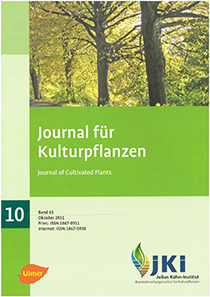Lethal effect of sulfuryl fluoride on eggs of different age of the Indian meal moth Plodia interpunctella (Hübner) – demonstration of the no constancy of the ct product for control
Keywords:
Sulfuryl fluoride, Plodia interpunctella, eggs, stored products, moths, ct productAbstract
One to four day old eggs of the Indian meal moth Plodia interpunctella served for an investigation of their tolerance towards sulfuryl fluoride (SF) fumigation at 27°C and 65% relative humidity and of the question of constancy of the lethal dosage of SF – the ct product (ctp) of the lethal concentration and the lethal exposure time – for different concentrations and exposure periods.
In many experimental series at fixed concentrations between 1 g/m3 and 6.24 g/m3 and exposure times between one and four days, egg age influenced the degree of mortality results. With few exceptions, one day old eggs tolerated the gas more than the other age groups of eggs at exposures of one to three days. 6.24 g/m3 caused full mortality of all young and older eggs in the test after three days of fumigation [ctp100 = 450 gh/m3] as well as 1.99 g/m3 within four days [ctp100 = 191 gh/m3].
Probit analysis and nonlinear regression of the mortality data resulted into an intensive discussion and into several tables and figures of lethal ct products as function of lethal exposure times and lethal concentrations. Ct products for 95% and 100% mortality, ctp95 and ctp100, of all implemented eggs showed minima for four days exposure, strong dependency of the age of the treated eggs and strong variations depending on the lethal concentration of SF. Regression led to a final figure showing the lethal exposure time between one and four days of treatment as function of the corresponding necessary lethal concentration of SF.
Many accessible data from the literature and various tests confirmed the tendency of the presented results, showing the relative susceptibility of eggs of Plodia interpunctella in comparison with eggs of other stored product pest insects. For the first time, the lethal effect of SF was discussed in detail as a function of age of treated eggs of this moth for better understanding of the no constancy of the lethal ct product.
DOI: 10.5073/JfK.2011.10.02, https://doi.org/10.5073/JfK.2011.10.02








